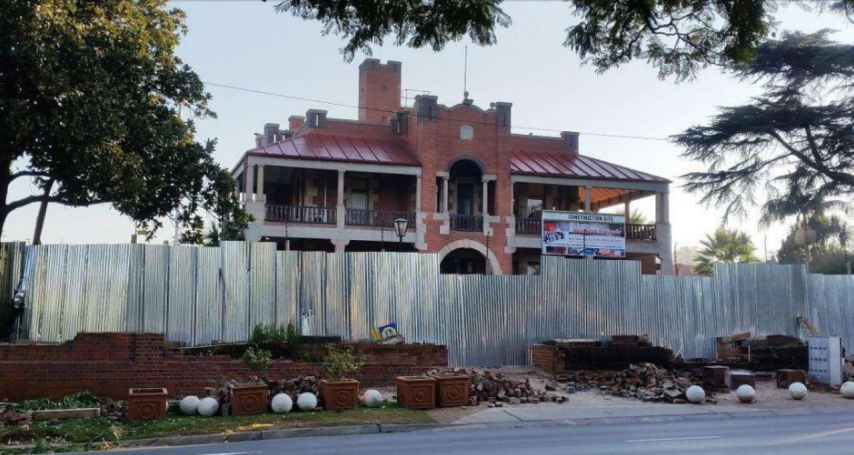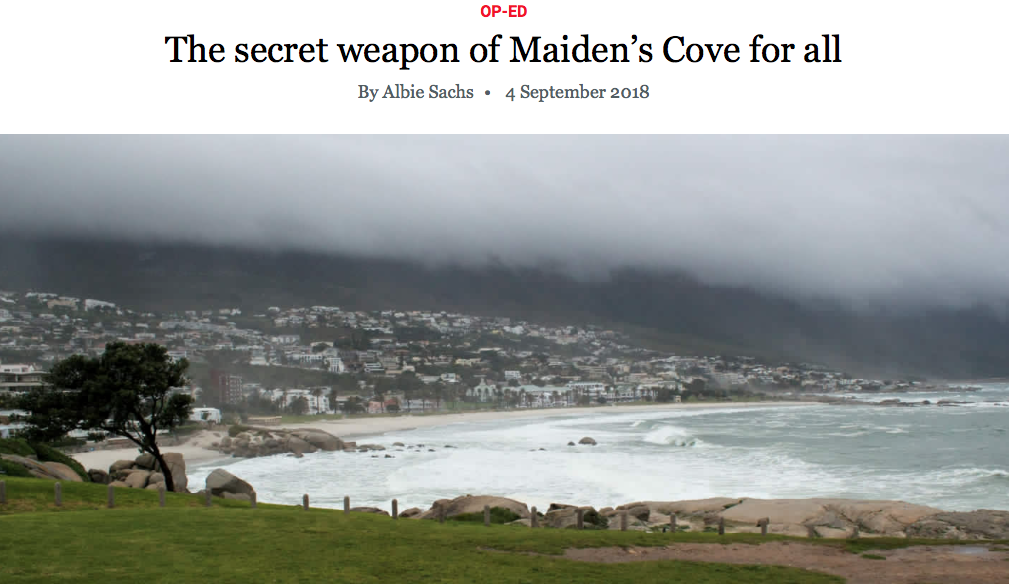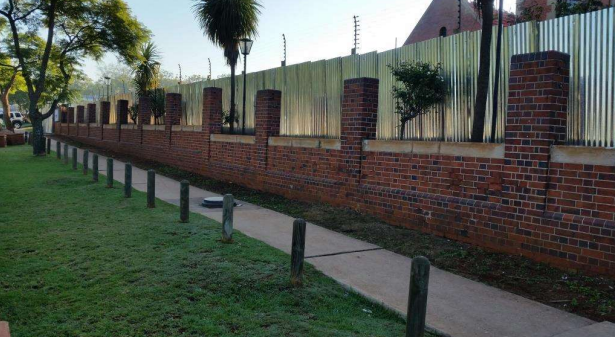
Disclaimer: Any views expressed by individuals and organisations are their own and do not in any way represent the views of The Heritage Portal. If you find any mistakes or historical inaccuracies, please contact the editor.
The local controversy over the development of the public space at Maiden's Cove on the Atlantic Seaboard of Cape Town has been brought to national attention in an article by the distinguished retired Constitutional Court Judge, Albie Sachs. “The Secret Weapon of Maiden's Cove for All” (Daily Maverick, 4 September 2018), hones in on some of the most complex and persistent challenges in the heritage sector: How to define heritage? Whose heritage is it? How should public participation be conducted? What are the responsibilities of the various spheres of government? And how does the bureaucracy carry out its responsibilities, if at all?
Screenshot from Albie Sachs' Daily Maverick article
Heritage practitioners and activists often crash their heads into a stone wall of developer and planner-generated rhetoric; especially claims that mega-plans conform to government policy and legislation. Often, the key point in the narrative is the national policy of “Densification” that purports to allow the construction of mega-buildings regardless of their immediate surroundings, whether that includes historic buildings, or a pristine environment, or not. The Maiden's Cove controversy illustrates the issues. Albie Sachs puts the challenge very eloquently, describing Maiden’s Cove as:
“...a precious heritage site now threatened with crass money-making development by the very body that should be its protector, the Cape Town City Council.”
He lambastes the council with the searing words, “...the protector has become the predator”!
He could be describing any number of heritage sites threatened by development across the whole country and any number of local governments. Municipalities from the south to the north are inclined to fall in line with developers' proposals, citing the requirements of national policy and legislation. There is nothing more damaging to public trust than to have public officials dismissing carefully presented arguments simply because they are against government policy, but this happens time and time again.
Densification is an important government policy and is seen as a remedy for the ills of apartheid spatial planning. However, in most respects it remains a “policy” without the necessary legislative instruments (regulations and by-laws) needed to flesh it out and to administer it properly. The ugly outcome is uncertainty and confusion which leads to arrangements which serve narrow interests without the opportunity for effective input from those most affected. The narrow interests are usually the financial interests of property developers and the built and natural environments and the rights of community members are usually, subtly, or blatantly, ignored. Sachs has highlighted this very well. But part of the problem, which he does not unpack, lies with the constitutional and legislative tangle surrounding heritage and planning legislation. Another part of the problem rests squarely on councillors and bureaucrats who are unable or unwilling to implement the legislation they are charged with implementing.
In 1995 the new democratic parliament passed the Development Facilitation Act (No 67 of 1995), which, according to its preamble, was designed to, “introduce extraordinary measures to facilitate and speed up the implementation of reconstruction and development programmes and projects in relation to land; and in so doing to lay down general principles governing land development throughout the Republic”.
The DFA was aimed at repealing racially-based apartheid planning legislation and it swept aside a mishmash of local and provincial ordinances from the four old provinces. Necessary for the times, it was, nevertheless, a hastily drafted interim measure that required major refinement. It was therefore replaced by the Spatial Planning and Land Use Management Act (No 16 of 2013), generally known as SPLUMA.
This is a framework law that provides a set of broad principles that have been fleshed out by provincial enactments. Gauteng promulgated its provincial regulations in 2015. SPLUMA is also intended to provide clarity on how planning legislation interacts with other laws and policies. While many processes and procedures for managing spatial development are comprehensively addressed in the regulations, one of the major problems is the limited opportunity provided for public participation. According to Sachs, in the Maiden Cove case, the City of Cape Town attempted to pre-select the public to be consulted. This denied a voice to the nearby community who claim the open space as part of their heritage.
Heritage activists will know how difficult it is to advance arguments for the protection of the built environment in front of municipal planning tribunals. The most important reason for this is the disjuncture between overall planning policy imperatives and heritage legislation. Developers chant the mantra that their developments conform to overall requirements for densification and heritage activists are immediately on the back foot. The process is systemically biased. Big developers have money, community activists have to fight using their own resources and the state (in the form of municipalities) is not impartial either.
It is not easy getting traction when the heritage legislation that is relied upon to underpin arguments is not fully fleshed out and, consequently, it is easy to ignore or over-ride. However, the problem is deeper than the legislation: there is indifference in all spheres of government, towards heritage, even to the extent of failing to follow the legislation that officials are required to implement.
Let us deal with the legislation first, the starting point must be the Constitution of the Republic of South Africa (Act No 108 of 1996). Schedule 4 of the constitution sets out the “concurrent” competences shared between the national, provincial and local spheres of government. Of significance here are the following:
- Urban and Rural Development
- Municipal Planning
- Cultural Matters (Heritage is subsumed under this heading)
Schedule 5 sets out the exclusive competences and three are relevant here:
- Local Amenities
- Provincial cultural matters
- Public places
Albie Sachs's article relates all these broad mandates to the specifics of one heritage-rich area, Maiden's Cove. He relies heavily on the National Heritage Resources Act (No 25 of 1999), the purpose of which is to provide for an, “integrated and interactive system for the management of the national heritage resources; to promote good governance at all levels and empower civil society to nurture and conserve their heritage resources so that they may be bequeathed to future generations”. However, given the tangle in the constitutional schedules, this is not an easy matter. Sachs's main target is the City of Cape Town which he excoriates for failing to implement its own laws and by-laws and for not fulfilling its legal obligations of consulting with the heritage authorities and with the broad public before taking its pro-development position.
The issue of the developments impinging on the protected area of the Bo-Kaap have also been well aired in the media. Not only is this a question of protecting architectural heritage, but also a question of class and race. The long time inhabitants of the Bo-Kaap are working class members of the coloured community who are neither as powerful, nor as well heeled, as the developers.
This impacts on small scale as well as on large scale developments because context is critically important as can be demonstrated by a protracted battle in the Observatory area. Here, in a proclaimed “heritage overlay protection zone”, a resident submitted misleading plans about changes to a dwelling and began to build before receiving planning permission from the municipality. Several residents fiercely objected both to the HWC and to the City Council. Upon realising that it had been misled, the HWC revoked its permit, but, being seriously underfunded, it lacks the wherewithal to take the matter to court and pursue criminal charges in terms of the Heritage Act. Without a court ruling, the HWC cannot enforce its own decisions.
The authority to order the removal of the illegal building is therefore vested in the City of Cape Town rather than the HWC. Despite the fact that the matter has also been ruled upon by both the municipal planning tribunal and by the municipal court and significant fines have been levied, the City of Cape Town is still reluctant to act. It takes refuge behind a smoke-screen of due process requirements.
The offending illegal structure still looms over the skyline and the street-scape in the heritage overlay protection zone. The multitude of objections are swept aside notwithstanding that it has been cogently demonstrated that the City is bound by its own by-laws and by national regulations to refuse planning permission and order the removal of the illegal structure. The fact that the offender is a municipal employee with family connections within the municipality, may or may not have some bearing on this reluctance to take action, but the appearance of impropriety is inescapable. However, this would have to be established by a proper enquiry set up to examine the issue of collusion between councillors, municipal officials and developers.
Another matter that requires urgent investigation is the lack of clarity between planning processes and heritage protection and the weaknesses in the legislation regarding public participation requirements. Sachs accused the City of Cape Town of not being proactive in engaging with the HWC before deciding on its desired development, as he put it, the protector had turned into a predator. There are no national regulations setting out how public participation must be undertaken.
The NHRA establishes the South African Heritage Resources Agency (SAHRA) at national level and gives provincial MECs the power to establish provincial heritage agencies. The responsibilities and functions of SAHRA and the overall South African heritage framework is well set out. The weakness is in the lack of regulations. The regulations that do exist are technical and operational.
Only two provinces have been really proactive in promulgating regulations: namely, KwaZulu-Natal and the Western Cape. As the Maiden Cove controversy has revealed, even the strict Western Cape heritage regime has its weaknesses.
The national Minister of Arts and Culture may determine when a province has the capacity to take over the functions of SAHRA and again KZN and the Western Cape are leading the way here. Gauteng received ministerial blessing because it provided a budget for what is now called PHRA-G (Provincial Heritage Resources Agency – Gauteng). It is unclear as to what other criteria were applied when the national minister was advised to take this decision. Certainly the history of PHRA-G is not a happy one and questions as to lack of capacity, lack of funding and serious conflicts of interest hang over the organisation. Another question that has been repeatedly asked, is when will the Gauteng MEC promulgate regulations in terms of the act?
Surrey House Johannesburg - Headquarters of the PHRAG (The Heritage Portal)
Given the overall densification policy, the lack of heritage regulations favours developers and handicaps heritage activists. Calling the MEC and the PHRA-G to account is a lot more difficult when there are no regulations providing for what official actions should be taken and what the time frames should be. For example, in 2016, Pretoria heritage activists appealed against a PHRA-G decision to allow the Indian High Commission (embassy) to proceed with changes to its historic boundary walls. The PHRA-G appeal committee upheld the original decision, arguing that it had no authority over diplomatic premises. This is a fig-leaf for inaction as there is an international convention applicable in this case. It is interesting to note that the PHRA-G issued a permit for the work to be carried out at the High Commission notwithstanding that it alleges it had no authority over the diplomatic premises concerned.
Indian High Commission boundary wall before demolition (OPERRA)
The activists appealed to the MEC in 2016 and, in terms of the NHRA, the MEC is required to appoint an expert group to advise her on how to proceed. At the time of writing the expert group has not yet met with the appellants and the matter has been dragging on for nearly three years. There are no regulations in Gauteng laying out when and how expert groups should be appointed, nor on how they should function. A question in the provincial legislature, asking when the expert group would report back to the MEC, was fobbed off with the answer, “when their report is finished”.
Furthermore, the lack of national and provincial regulations raises questions around governance including the selection of members of SAHRA and the PHRA-G. The current chairperson of SAHRA is also the chairperson of PHRA-G and also chairs the PHRA-G appeal committee (whether this is done regularly or on an ad hoc basis is unclear). The NHRA may have been intended to promote “good governance”, but clearly there are problems within the PHRA-G and the provincial department and, more broadly, with intergovernmental relations in the whole Gauteng province.
Also, without regulations, there is no way of knowing how conflicts of interest within the PHRA-G are managed. It is a well known fact that certain PHRA-G members work professionally for developers as heritage consultants which is not illegal. It may well be that conflicted consultant/council members recuse themselves in meetings when their reports appear on the agenda. However, without clear regulations governing the management of conflicts of interest, there is no way for outsiders to know what advice is given outside the confines of the formal appeal meetings. There is simply no transparency, and this calls into question the good governance, integrity and professionalism of the PHRA-G as a whole.
In the case of the dispute over the Indian High Commission, the heritage practitioner who advised the PHRA-G that the wall could be demolished, was a member of the PHRA-G council and was seen talking to the Chairperson of the Appeals Committee shortly before the meeting at which the objectors were to present their case. It may have been entirely innocent, but without regulations and a code of conduct, it is impossible to tell. Rumours of collusion between the PHRA-G and its officials, on the one side, and developers on the other, abound.
What do we learn from these lessons in the north and the south of the country? The first lesson is that there is an urgent need for the national Department of Arts and Culture to take the lead in aligning heritage legislation with planning legislation. Planners, architects, heritage practitioners and other interested and affected parties should be brought together to advise government on how this can be done. Many planners have expressed the view that they would welcome such a learning opportunity.
The second lesson is that the fine sentiments in the NHRA must be fleshed out in appropriate regulations. While the provinces necessarily play a critical role in this, the national department should take the lead and issue the guidelines that it is constitutionally empowered and entitled to issue. These guidelines should also include procedures and criteria for the appointment of council members to SAHRA and to the various PHRAs. There should be a code of conduct for such members (the Western Cape could provide assistance here). There should also be guidelines outlining public participation processes in relation to heritage nominations, objections and appeals.
DAC should also assist the provinces in compiling nuts and bolts directives: how appeals should be lodged, who should handle them and what the time-frames should be? What DAC does not seem to have grasped is how much money is usually at stake in conflicts between the heritage and the development sectors (which makes such disputes difficult to resolve) and it is the role of government to mediate in such conflicts for the broader common good.
Perhaps the first step on a new road forward would be for DAC (in conjunction with other national departments, the provinces and major local authorities as well as heritage practitioners, architects, other experts and community stakeholders), to convene a national conference to examine how to align heritage and spatial planning legislation and to devise ways for complementary, rather than conflictual implementation. But the conference should not merely be a talk-shop, it should be aimed at developing a system to harmonise the implementation of spatial planning and heritage legislation in all spheres of government. This would be one way of turning predator officials back in to protector officials.
Dr Graham Dominy is the outgoing Heritage Convenor of the Old Pretoria Residents and Ratepayers Alliance (OPERRA). He is the former National Archivist of South Africa and is currently a Research Fellow at both UNISA and the Helen Suzman Foundation. In October he will be assuming duties as head of the archives and manuscripts section at the “Oman Across the Ages” museum project based in the Sultanate of Oman. He writes in his personal capacity and the views expressed in this article do not necessarily represent those of any of the organisations to which he is affiliated.
Comments will load below. If for any reason none appear click here for some troubleshooting tips. If you would like to post a comment and need instructions click here.


